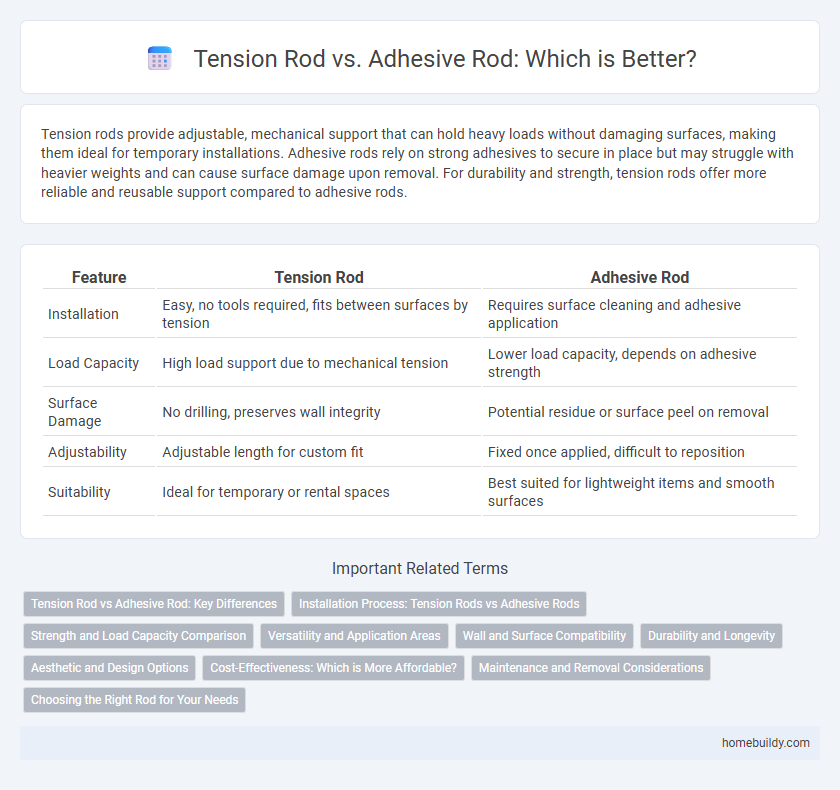Tension rods provide adjustable, mechanical support that can hold heavy loads without damaging surfaces, making them ideal for temporary installations. Adhesive rods rely on strong adhesives to secure in place but may struggle with heavier weights and can cause surface damage upon removal. For durability and strength, tension rods offer more reliable and reusable support compared to adhesive rods.
Table of Comparison
| Feature | Tension Rod | Adhesive Rod |
|---|---|---|
| Installation | Easy, no tools required, fits between surfaces by tension | Requires surface cleaning and adhesive application |
| Load Capacity | High load support due to mechanical tension | Lower load capacity, depends on adhesive strength |
| Surface Damage | No drilling, preserves wall integrity | Potential residue or surface peel on removal |
| Adjustability | Adjustable length for custom fit | Fixed once applied, difficult to reposition |
| Suitability | Ideal for temporary or rental spaces | Best suited for lightweight items and smooth surfaces |
Tension Rod vs Adhesive Rod: Key Differences
Tension rods rely on adjustable spring mechanisms to create pressure between two surfaces, offering strong hold without permanent fixtures. Adhesive rods use high-strength glue or suction cups to attach to surfaces, making installation simpler but often less reliable under heavy loads. Key differences include the tension rod's reusability and load-bearing capability versus the adhesive rod's ease of installation and potential for surface damage.
Installation Process: Tension Rods vs Adhesive Rods
Tension rods require no tools, relying on a spring mechanism to fit securely between two surfaces, making installation quick and adjustable. Adhesive rods involve applying strong glue or tapes to adhere the rod to a surface, demanding precise placement and curing time for effective bonding. Tension rods offer reusable and damage-free installation, while adhesive rods provide a more permanent solution but risk wall damage upon removal.
Strength and Load Capacity Comparison
Tension rods typically exhibit higher strength and greater load capacity compared to adhesive rods due to their solid metal construction and ability to withstand tensile forces without deformation. Adhesive rods rely on bonding agents that may weaken under heavy loads or prolonged stress, limiting their overall durability and strength. For applications requiring robust support and significant weight-bearing capacity, tension rods are a more reliable choice.
Versatility and Application Areas
Tension rods excel in versatility, supporting a wide range of applications including curtains, shower screens, and lightweight room dividers without damaging walls. Unlike adhesive rods, which rely on sticky backing limited by surface type and humidity, tension rods use adjustable spring mechanisms to securely fit various widths and accommodate different wall materials. Their adaptability makes tension rods ideal for temporary or permanent installations in bathrooms, kitchens, and living spaces where frequent repositioning may be required.
Wall and Surface Compatibility
Tension rods rely on adjustable pressure to secure firmly between two walls, making them ideal for surfaces that can withstand force without damage, such as tile or sturdy drywall. Adhesive rods depend on strong glue or suction pads, offering versatility on delicate or uneven surfaces like painted walls or textured tiles where mechanical pressure could cause marks. Choosing between tension and adhesive rods hinges on the wall material's ability to bear tension and its surface texture compatibility.
Durability and Longevity
Tension rods made from high-quality steel offer superior durability and longevity compared to adhesive rods, which often degrade with moisture and heat exposure. Unlike adhesive rods, tension rods maintain their structural integrity under varying loads and environmental conditions without losing grip or support. This makes tension rods a reliable choice for long-term applications in both residential and commercial settings.
Aesthetic and Design Options
Tension rods offer sleek, minimalist designs that seamlessly blend with various interior styles, providing a clean and unobtrusive appearance. Unlike adhesive rods, tension rods do not rely on visible mounting hardware or glue, preserving wall integrity and allowing easy repositioning without damage. This versatility in placement and finish options enhances aesthetic appeal and supports diverse decorative schemes in homes and offices.
Cost-Effectiveness: Which is More Affordable?
Tension rods typically offer a more cost-effective solution compared to adhesive rods due to their reusable nature and durability, reducing the need for frequent replacements. Adhesive rods often incur higher long-term costs as the adhesive weakens over time, necessitating additional purchases and potential damage to surfaces. Choosing tension rods minimizes expenses while providing a reliable and adjustable option for hanging curtains and other items.
Maintenance and Removal Considerations
Tension rods require minimal maintenance, often just occasional adjustments to maintain proper tension and stability without damaging walls. Adhesive rods may degrade over time, leading to residue build-up that complicates cleaning and removal, potentially damaging paint or wallpaper. Removing tension rods is straightforward and non-invasive, while adhesive rods often require careful peeling and solvent use to avoid surface damage.
Choosing the Right Rod for Your Needs
Tension rods offer adjustable strength and versatility for varying load requirements, making them ideal for holding heavy curtains or creating stable room dividers, while adhesive rods provide easy installation and damage-free mounting suitable for lightweight curtains or temporary setups. Evaluating your specific needs like weight capacity, surface type, and permanence helps determine the optimal choice between tension and adhesive rods. Selecting a high-quality tension rod ensures durability and reliable support, whereas adhesive rods are best for convenience and quick fixes without drilling.
tension rod vs adhesive rod Infographic

 homebuildy.com
homebuildy.com